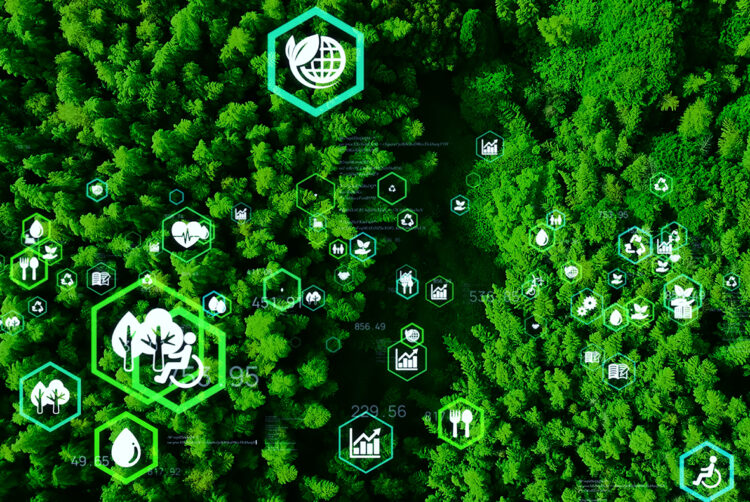Paper v pixels: Making a sustainable advertising choice

Opinion
Understanding the environmental impact of both print and digital advertising is crucial for brands to make sustainable choices that benefit consumers and society.
Technology and the internet have fundamentally changed how media is produced and consumed. However, contrary to early predictions, online media has not eradicated print; the two exist in parallel through consumer choice.
But what impact does each have on our environment and society?
Sustainability of paper
Paper provides a tangible and tactile experience and can be perceived as more authoritative in certain contexts. However, it also comes with environmental concerns and practical limitations.
Data from Guardian Media Group (GMG) reveals that 71% of the company’s 2021/22 emissions came from print products, totalling 16,969 tonnes of carbon dioxide — equal to roughly 2,000 UK homes. In comparison, digital products accounted for 11% of GMG’s carbon footprint in 2021/22.
On the surface, this makes print look like a less environmentally friendly option. However, other factors need to be considered.
Between 1990 and 2019, the paper industry reduced its carbon emissions by 48% and it’s the biggest single user of renewable energy in Europe.
Furthermore, trees from the pulp and paper industry come from sustainably managed forests. The industry’s continued efforts mean that forests in Europe are growing in size by the equivalent of 1,500 football pitches every day.
Finally, 71% of waste paper in Europe is collected and recycled — that’s higher than glass, metal and plastic.
Device recycling
Those who claim print media is a more sustainable option often say the electronic devices we use to consume digital media rely on extractive mining of non-renewable materials and are rarely recycled.
However, there is a growing awareness among consumers about the importance of recycling devices. Propelled by initiatives from bodies such as the United Nations International Telecommunication Union, the global mobile phone recycling service market is set to grow significantly.
Phone manufacturers are also working to ensure new models are significantly “greener”. This goes beyond niche providers such as Fairphone and Teracube, with a recent article in ZDNet ranking the Apple iPhone 14 Pro as the most sustainable phone overall.
Potential to improve
Another key factor to consider is carbon emissions.
At PubMatic, we estimate that nearly 98% of our electricity usage happens in the data centres used to process ad impressions. All our data centres globally are powered exclusively by renewable energy. This means, in the UK alone, PubMatic avoided emitting 321 tonnes of carbon — the equivalent of the electricity consumed by 41 homes for a year.
The vital role that data centres play in delivering relevant, impactful digital ad experiences grows daily. So we have an opportunity to make huge gains in prioritising data centres that employ renewable energy sources. This allows our industry to continue to refine its practices, while reducing its carbon footprint in the area where the greatest energy consumption is occurring.
Additionally, marketers and media agencies can now calculate the carbon cost of their digital campaigns, connect to media owners that share a commitment to sustainability and honour the expectations of increasingly climate-conscious consumers.
The transparency of data-driven marketing operations — where every process can be logged and analysed — allows participants to understand where inefficiencies lie and take proactive action to drive carbon reduction.
Driving positive change
Beyond reducing the carbon we pump into the atmosphere and the resources we extract from the planet, driving sustainability is also about educating and inspiring the public to act. Today, the majority of that messaging reaches people digitally, with consumers spending an average of six hours and forty minutes online every day.
Paper can’t animate, it can’t speak out loud, it can’t play a video and its content can’t be translated in real time or shared with family and friends at the click of a button.
What’s more, premium publishers can share responsibly reported news with greater audiences than just through print alone, all funded by digital marketing and advertising. Local businesses, too, can benefit by reaching more local buyers, driving sustainable shopping and engagement within their own communities. The list goes on.
With digital media, driving impactful change towards a greener future is made less complex. Different groups can be reached with tailored, sustainable messaging that is most effective for them — moving beyond one-size-fits-all communication methods that are often wasted or ignored.
Economic good
Sustainability is a hard sell if it doesn’t also drive economic growth. IAB UK’s Digital Dividend report found that every £1 spent on digital advertising contributes £4.80 to the UK economy.
So much of what contributes to the richness of our culture and creates lasting value is promoted and discovered digitally. And this is being delivered by an industry committed to being net zero by 2030.
By combining the strengths of both print and digital, organisations can create a rounded communication strategy that caters to diverse audience preferences.
It’s only by gaining a unified view of both that we can accurately gauge the carbon impact of media and marketing as a whole and make sustainable decisions.
 Emma Newman is chief revenue officer, EMEA, at PubMatic
Emma Newman is chief revenue officer, EMEA, at PubMatic




